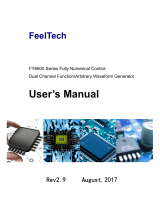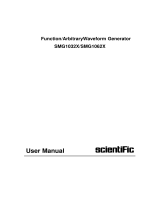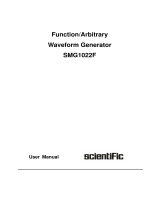Page is loading ...

SDG6000X Series
Pulse/Arbitrary
Waveform Generator
Quick Start

I-SDG6000X Quick Start
Copyright
SIGLENT TECHNOLOGIES CO., LTD. All rights reserved.
Information in this publication replaces all previous corresponding material.
SIGLENT reserves the rights to change the specications and the price.
Without permission, contents in this manual are not allowed to be copied, extracted or translated.
c

SDG6000X Quick Start -II
Carefully read the following safety precautions to avoid any personal injuries or damages to the instrument and any product connected to it. To avoid potential
hazards, please use the instrument as specied.
Only the qualied technician can service the instrument.
Avoid re or personal Injure.
Use proper power line —— Use only the special power line which approved by local state.
Ground the Instrument —— The instrument is grounded through the protective terra conductor of the power line. To avoid electric shock, the ground conductor
must be connected to the earth. Make sure the instrument is grounded correctly before connecting its input or output terminals.
Connect the signal wire correctly —— The potential of the signal wire ground is equal to the earth, so do not connect the signal wire to a high voltage. Do not
touch the exposed contacts or components.
Observe all terminal ratings —— To avoid fire or electric shock, please observe all ratings and sign instruction on the instrument. Before connecting the
instrument, please read the manual carefully to gain more information about the ratings.
Do not operate with suspected failures —— If you suspect that the product is damaged, please let a qualied service personnel check it.
Avoid circuit or wire exposure —— Do not touch exposed contacts or components when the power is on.
Do not operate in wet/damp conditions.
Do not operate in an explosive atmosphere.
Keep the surface of the instrument clean and dry.
Safety Terms and Symbols
Terms used on the instrument. Terms may appear on the instrument:
DANGER: Indicates an injury or hazard that may immediately happen.
WARNING: Indicates an injury or hazard that may not immediately happen.
CAUTION: Indicates that a potential damage to the instrument or other property might occur.
General
Safety
Summary
Hazardous
Voltage
Warning Protective
Earth Ground
Chassis
Ground
Power
Switch
Symbols used on the instrument. Symbols may
appear on the instrument:

1-SDG6000X Quick Start
Content
Copyriht..................................................................
General Safety Summary..........................................
Adjust the Handle....................................................
The Front Panel ......................................................
The Rear Panel........................................................
Touch Screen Display...............................................
Use Built-In Help System..........................................
Introduction of EasyWaveX.......................................
Introduction of EasyIQ.............................................
Contact SIGLENT.....................................................
I
II
2
3
10
13
16
17
18
19

SDG6000X Quick Start -2
When using the instrument, users can adjust the handle to a needed position which makes it easier to
operate and observe.
Horizontal Position
Carrying Position
Figure 1 Adjust the Handle
Adjust
the Handle

3-SDG6000X Quick Start
1
2
3
11
10 8
9
4
5
6
7
1. Power Key
2. USB Host
3. Touch Screen Display
4. Numeric Keyboard
5. Knob
6. Arrow Keys
7. CH1/CH2 Control/
Output Port
8. Channel Select Key
9. Function Keys
10. Waveform Option
11. Menu Keys
Figure 2 SDG6000X Front Panel
The Front
Panel

SDG6000X Quick Start -4
1.Power Key
This key is used to turn on/off the AWG. When the power key is off, the AWG is in the power off state.
2.USB Host
SDG6000X supports USB memory devices (U-Disks) using the FAT format. An external USB memory device can be used to store and recall waveforms or state les
for use with the instrument. Users can also update the rmware using U-Disks.
3.Touch Screen Display
SDG6000X has a 4.3 inch TFT-LCD touch screen, which displays current function menu, parameter settings, system state, prompts, etc. For detailed information,
please refer to “Touch Screen Display”.
4.Numeric Keyboard
Consists of numbers from 0 to 9, radix points “.” and symbol keys “+/-”, which are used to input parameters.
Note
:
To enter a negative number, you need to enter a symbol “-” at rst.
5.Knob
It is used to increase (clockwise) or decrease (counterclockwise) the current numerical value when setting parameters.
It is also used to switch characters in the soft keyboard when inputting a le name.
When saving or reading les, rotate the knob to choose a position to save a le or choose a le to be read; press the knob to open a selected folder or le.
When choosing Waveforms
→
Page 1/2
→
Arb
→
Arb Type rotate the knob to select a desired built-in or stored waveform.
6.Arrow Keys
When using the knob to set parameters, the arrow keys can be used to select the digit to be modied.
When using the numeric keyboard to set parameters, the left arrow key is used as a Backspace function.
When inputting a le name, they are used to move the position of the cursor.

5-SDG6000X Quick Start
7.Channel Control Area
CH1 Control/Output Key
The Output key on the left is used to turn on/off the CH1 output.
The nominal output impedance of the BNC connector is 50Ω.
When pressing Output (the key backlight turns on), the connector outputs the waveform according to the current conguration of CH1.
CH2 Control/Output Key
The Output key on the right is used to turn on/off the CH2 output.
The nominal output impedance of the BNC connector is 50Ω.
When pressing Output (the key backlight turns on), the connector outputs the waveform according to the current conguration of CH2.
A long press of the output key (>2 s) switches the output load setting between 50Ω and HiZ.
8.Channel Select Key
This key is used to switch the current selected channel between CH1 and CH2.
CAUTION:
Overvolltage protection of CH1 and CH2 will take effect once any of the following conditions is met. When overvoltage protection occurs, a
message will be displayed and the output is disabled.
• The absolute value of input voltage is higher than 11V±0.5V when the amplitude of the generator is higher than or equal to 3.2Vpp or the
DC offset is higher than or equal to |2VDC|.
• The absolute value of input voltage is higher than 4V±0.5V when the amplitude of the generator is lower than 3.2Vpp and the DC offset is
lower than |2VDC|.
If an overvoltage protection occurs, a message will be displayed and the output will be disabled.
Choose Utility
→
Page 1/2
→
OverVoltage Protection to turn on/off the function.

SDG6000X Quick Start -6
9.Function Keys
Mod ----Modulation
This key is used to enable the modulation screen and allow for several types of modulation. It generates AM, DSB-AM, FM, PM, ASK, FSK and PWM modulated
signals.
• It supports “Internal” and “External” modulation sources.
• The corresponding key backlight will turn on when this function is selected.
Sweep ----Sweep
This key is used to generate sweeping frequency signals of Sine, Square, Ramp and Arbitrary.
• It supports “Linear” and “Log” sweep proles.
• It supports “Internal”, “External” and “Manual” trigger sources.
• The corresponding key backlight will turn on when this function is selected.
Burst ----Burst
This key is used to generate burst signals of Sine, Square, Ramp, Noise and Arbitrary.
• It supports “NCycle”, “Gated” and “Innite” burst modes.
• Noise can only be used to generate gated burst.
• It supports “Internal”, “External” and “Manual” trigger sources.
• The corresponding key backlight will turn on when this function is selected.
Parameter ----Parameter Setting
Users can switch directly to the parameter setting interface by pressing the key.
• The corresponding key backlight will turn on when this function is selected.

7-SDG6000X Quick Start
Utility ----Utility Functions and System Settings
This key is used to set system parameters and check version information.
• Press this key and then press the help softkey to obtain built-in help information about the product.
• The corresponding key backlight will turn on when this function is selected.
Store/Recall ----Store and Recall
Through this key, users can store/recall the instrument’s state or arbitrary waveform data edited by users.
• Perform general le operations, such as Save, Save As, Delete, and others.
• In addition to the built-in nonvolatile memory (C disk), an external USB memory device can also be used.
• The corresponding key backlight will turn on when this function is selected.
10.Waveform Option
Waveforms ---- Sine
Provide sine waveform output with a frequency ranging from 1 μHz to 500 MHz.
Enabling the "harmonic" function permits adding sinewave harmonics up to the 16th order to the basic frequency.
• The backlight of Waveforms will turn on when this function is selected.
• “Frequency/Period”, “Amplitude/High level”, “Offset/Low level” and “Phase” of the sine waveform can be adjusted.
Waveforms ---- Square
Provide square waveform output with a frequency ranging from 1 μHz to 120 MHz.
The backlight of Waveforms will turn on when this function is selected.
• “Frequency/Period”, “Amplitude/High level”, “Offset/Low level”, “Phase” and “Duty” of the square waveform can be adjusted.

SDG6000X Quick Start -8
Waveforms ---- Ramp
Provide ramp waveform output which ranges from 1 μHz to 5 MHz.
• The backlight of Waveforms will turn on when this function is selected.
• “Frequency/Period”, “Amplitude/High level”, “Offset/Low level”, “Phase” and “Symmetry” of the ramp waveform can be adjusted.
Waveforms ---- Pulse
Provide pulse waveform output with frequencies that range from 1 μHz to 150 MHz.
• The backlight of Waveforms will turn on when this function is selected.
• “Frequency/Period”, “Amplitude/High level”, “Offset/Low level”, “Pulse width/Duty”, “Rise/Fall” and “Delay” of the pulse waveform can be adjusted.
Waveforms ---- Noise
Provide White Gauss Noise output with a bandwidth of 500 MHz.
• Enabling the "BandSet" function permits setting the bandwidth between 80 MHz ~ 500 MHz .
• The backlight of Waveforms will turn on when this function is selected.
• “Stdev” and “”Mean” of the noise signal can be adjusted.
Waveforms ---- Arb
Provide arbitrary waveform output with frequencies that range from 1 μHz to 50 MHz.
• The backlight of Waveforms will turn on when this function is selected.
• Support two output modes: “DDS” and “TrueArb”. In "TrueArb" mode the interpolation can be set as "Zero-order hold" or "Linear".
• Built-in waveforms include Cardiac, Gauspuls, ExpRise and ExpFall, etc. In addition, the output waveform stored on the U-Disk can be sourced.
• Users can edit arbitrary waveforms through EasyWaveX and download them to the instrument.
• “Frequency/Period”, “Amplitude/High level”, “Offset/Low level” and “Phase” of the arbitrary waveform can be adjusted.

9-SDG6000X Quick Start
Waveforms ---- IQ
Provide IQ waveform output with center frequencies ranging from 0 Hz to 500 MHz.
• Support modulation types including 2ASK, 4ASK, 8ASK, BPSK, QPSK, 8PSK, DBPSK, DQPSK, D8PSK, 8QAM, 16QAM, 32QAM, 64QAM, 128QAM, 256QAM, 2FSK,
4FSK, 8FSK, 16FSK, MSK, Multi-tone
• Support data patterns including PN7, PN9, PN15, PN23, User le and Custom
• Built-in waveforms can be recalled by pressing I/Q Data.
• Users can edit IQ waveforms through EasyIQ and download them to the instrument.
• “Fsymb/Fs”, “Amplitude” and “Center Frequency” of the IQ waveform can be adjusted.
Waveforms ---- PRBS
Provide PRBS output which ranges from 1μbps to 300Mbps.
• Support patterns from PRBS3 to PRBS32
• Supports setting the logic level quickly to TTL/CMOS, LVTTL/LVCMOS, ECL, LVPECL, LVDS
• Supports setting the two channels to differential mode quickly.
• “Bit Rate/Period”, “Amplitude/High level”, “Offset/Low level” and “Length” of the PRBS waveform can be adjusted.
11.Menu Keys
These keys correspond to the menu displayed above them on the display. Press any key to activate the corresponding menu.

SDG6000X Quick Start -10
1 2 3 5
4
678
Figure 3 SDG6000X Rear Panel
The Rear
Panel

11-SDG6000X Quick Start
1.Counter
BNC connector. The input impedance is 1MΩ. This connector is the input connection to the frequency counter.
2.Aux In/Out
BNC connector. The function of this connector is determined by the current operating mode of the instrument.
•
Sweep/Burst trigger signal input port of external trigger.
•
Sweep/Burst trigger signal output port of internal/manual trigger.
•
Burst gating trigger input port.
•
ASK/FSK external modulation signal input port.
•
Synchronization output port. When synchronization is on, the port can output a CMOS signal with the same frequency as basic waveforms (except Noise and DC),
arbitrary waveforms, and modulated waveforms (except external modulation).
•
AM, DSB-AM, FM, PM and PWM external modulation signal input port.
3.10 MHz Clock Input Port
BNC connector. If the instrument uses external clock source, the connector accepts an external 10MHz clock source.
4.10 MHz Clock Output Port
BNC connector. If the instrument uses internal clock source, the connector outputs the 10 MHz clock signal generated by the crystal oscillator inside the generator. If
an external clock is being used as a clock input, the instrument will pass-through the external clock.
5.Earth Terminal
Used to ground the instrument.

SDG6000X Quick Start -12
6.AC Power Supply Input
SDG6000X can accept two different types of AC input power.
AC power: 100-240V, 50/60Hz or 100-120V, 400Hz
Fuse: 1.25A, 250V
7.USB Device
Used when connecting the instrument to an external computer to allow waveform editing (such as EasyWaveX and EasyIQ) and remote control.
8.LAN Interface
Through this interface, the generator can be connected to your computer or network for remote control. An integrated testing system may be built, as the generator
conforms to the VXI-11 class standard of LAN-based instrument control, and supports remote control commands using open sockets or Telnet.

13-SDG6000X Quick Start
Touch
Screen
Display
Figure 4 Touch Screen Display
1
7
4
5
3
6
2
SDG6000X can only display the parameters and waveform type of one channel at a time. The picture below shows the interface when CH1 has been congured to
source an AM modulation of a sine waveform. The information displayed may vary depending on the function selected.
The entire screen of the SDG6000X is a touch screen. You can use your gure or touch pen to control the instrument. Most functions and selections can be chosen
using the touch screen in a similar manner to the front panel keys and knob.

SDG6000X Quick Start -14
1.Waveform Display Area
Shows the currently selected waveform of each channel. The key backlight will turn on when this area of the touch screen is pressed.
2. Channel Status Bar
Indicates the selected status and output conguration of the channels. Touch this area of the screen to switch to the corresponding channel. If you touch again, the
shortcut menus of function keys will be recalled: Mod
、
Sweep
、
Burst
、
Parameter
、
Utility and Store/Recall.
3. Basic Waveform Parameters Area
Shows the current waveform parameters of each channel. Touch this area of the screen to highlight the parameter you want to congure and use number keys or
knob to change the parameter value.
4. Channel Parameters Area
Displays the currently selected channel’s load and output settings.
Load -----Value of the output load, as selected by the user.
After choosing the parameter to highlight it, use the softkeys, number keys or knob to change the parameter value.
High Impedance: displays HiZ.
Load: displays the set impedance value (the default is 50Ω and the range is 50Ω to 100kΩ).
Note: This setting does not actually change the instrument’s output load impedance of 50Ω but rather is used to maintain amplitude accuracy into different load
values.
Output ----Channel output state.
After touching this area of the screen or pressing corresponding channel output control port, you can turn on/off the current channe
l.
5.Status Icon
LAN Status Icon
The SDG6000X will show different prompt messages based on the current network status.
Indicates LAN connection is successful.
Indicates there is no LAN connection or LAN connection is unsuccessful.
Phase Mode Icon
Indicates "Phase Locked" mode, in which both DDS reset when changing frequency. Phase deviation between CH1 and CH2 is maintained.
Indicates "Independent" mode, in which no DDS resets when changing frequency. Phase deviation between CH1 and CH2 is random.
The independent mode is recommended when the smoothest manual frequency transitions are required.
Choose Utility
→
Page 2/3
→
Phase Mode to choose the mode.

15-SDG6000X Quick Start
Clock Source Icon
Indicates the clock source is internal
Indicates the clock source is external
Indicates the clock source is external, but not available
6. Menu
Touch here for the menu corresponding to the displayed function. For example, the picture above shows the parameters of “AM modulation”. After touching the
menu on the touch screen to choose the corresponding parameter, use number keys or knob to change the parameter value.
7. Modulation Parameters Area
Shows the parameters of the current modulation function. After touching this area of the screen or pressing corresponding menu, use number keys or knob to
change the parameter value.

SDG6000X Quick Start -16
Use Built-
In Help
System
To obtain built-in help information of the product, please press Utility key rst, then press Page 1/2 and Help, use the knob to choose the help item you want,
nally press Select to obtain help information.

17-SDG6000X Quick Start
The SDG6000X series includes arbitrary waveform editing software called EasyWaveX. This software is a platform for easily creating, editing, and transferring
waveforms to the generator. It provides 11 standard waveforms such as Sine, Square, Ramp, Pulse, Noise and DC, which meets most engineers’ basic needs.
In addition, it provides several ways of manual drawing, point-to-point line drawing and arbitrary point drawing. EasyWaveX allows for fast and easy creation of
complex waveforms.
The main interface of EasyWaveX is shown in the following gure
Introduction
of
EasyWaveX
Figure 5 EasyWaveX Interface
/



